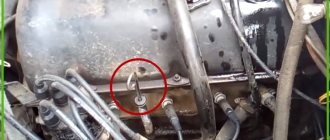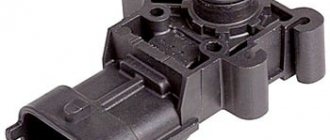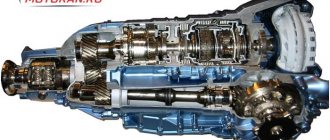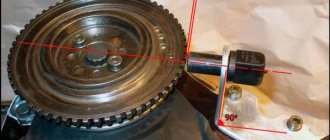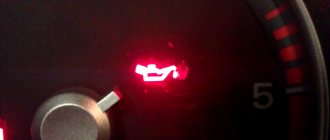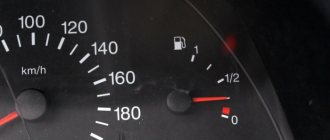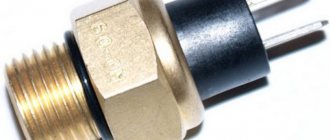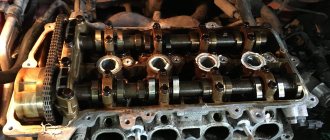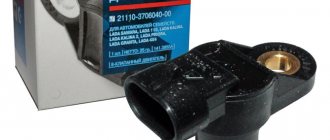Types of DDM
Oil pressure sensors are divided into two types:
- Mechanical. They are used on cars that have become legends in the automotive industry, in particular, VAZ 2101, UAZ, Moskvich 401/407/412/, 2141 and others.
- Electronic. Installed on all modern cars, for example, domestic VAZ 2114, Kalina and other Lada models, as well as foreign cars.
Mechanical sensors
Mechanical sensors by design are divided into:
- Devices with two rods and a capillary tube.
- Devices with a rheostat.
The first ones consist of a body, a membrane, two rods, and a sealed tube.
As the pressure in the lubrication system increases, the membrane bends, putting pressure on the first rod, thereby increasing the pressure in the tube. The second rod takes this pressure and transmits it to the differential pressure gauge (located on the instrument panel).
The pressure increases - the arrow of the device deviates in a larger direction, falls - the arrow goes down to the left. The principle of operation is the same as that of a pressure gauge.
The mechanical oil pressure sensor with rheostat consists of:
- Cases.
- Membranes.
- Slider.
- Nichrome winding (resistor).
The device operates on the principle of a voltmeter. The rheostat and slider play a key role here.
The rheostat changes its resistance depending on where the slider is moved. The latter, in turn, shifts in one direction or another as the membrane bends or straightens.
When there is no pressure, the membrane is not deformed and the slider does not move, the current passes freely without encountering any resistance along its path.
As the pressure increases and the membrane deforms, the slider moves along the rheostat, thereby increasing the resistance in the circuit; accordingly, the current readings change, which is displayed on the device in the driver’s cabin.
All this is recorded by the ECU, to which the sensor is connected. It is programmed in such a way that only one period of current values is equal to the standard oil pressure. Exceeding this interval is equivalent to an incorrect value.
This is clearly visible on dial analog pressure gauges, which, in fact, are ordinary voltmeters.
Electronic sensors
Electronic DDM is much simpler than its mechanical counterpart, so it is considered more reliable.
Essentially, this is an emergency sensor that does not show the pressure in the system, but only notifies the driver when it is within normal limits and when it is not.
It consists of:
- Cases.
- Membranes.
- Contacts
- Stock.
Principle of operation. When pressure is not applied to the sensor membrane, it is not deformed. The rod is in a position in which the circuit contacts are closed and current flows through them. At this moment, a lamp is lit in the cabin, which is monitored by the driver.
When the engine starts, the oil pressure in the system increases, the membrane bends, the rod moves, opening the circuit. The light goes out.
If after starting the engine the lamp does not go out within 1-2 seconds, you must immediately turn off the engine and do not start it until the cause of the malfunction is determined.
Read more here - what to do if the oil pressure light is on.
Based on the above, we can conclude that the basis for checking the oil pressure sensor on modern cars is measuring the resistor resistance with a multimeter and checking the DDM for opening and closing the circuit.
To do this, the multimeter is switched to resistance or continuity measurement mode. It depends on what type of sensor is being tested with or without a resistor.
But there are other verification methods, which we will discuss below.
Pressure check
The simplest and most convenient way of such diagnostics is to use the built-in sensor. These instruments for checking engine pressure are of the following types:
The most common are emergency devices. Most manufacturers prefer to install just such a compact version of the signaling device on the dashboard in the form of the well-known “burning oil can”. It operates in “on/off” mode and indicates to the driver that the oil pressure in the engine has completely lost. This device monitors critical drops in lubricant levels and allows you to avoid only the most serious consequences. Such as a breakdown within the next few hours or days due to a lack of lubricant.
The action of such an indicator is based on a membrane mechanism. After turning on the ignition, but with the engine and oil pump not running, the contacts of the device are closed and the “oiler” lights up. After starting the engine, the pressure increases, causing the diaphragm to bend and put pressure on the pusher. Which opens the circuit and turns off the indication. If the pressure drops again, the membrane returns to its original state and the contacts close, which leads to the appearance of a light signal.
Additional oil control sensors are more complex devices that display the exact value of the characteristic on a special dial. They allow you to control the operation of the lubrication system, which makes it possible to increase the service life of the motor.
Such indicators are:
- Mechanical. This device is based on a conventional mechanical pressure gauge. They can still be found on old cars.
- Electric. In this case, the mechanical force is translated into an electrical signal, which is analyzed by the car's on-board computer. Modern manufacturers more often use this type of alarm.
The operation of additional control devices is also based on membranes. In this case, the diaphragm, deformed under the influence of oil pressure, pushes the slider. It moves along a resistor with a nichrome winding, due to which the circuit resistance changes. Depending on this change, the arrow pointer on the device displays the corresponding parameter values.
Some manufacturers install both indicators on the dashboard, which allows you to monitor the necessary characteristics even if one of them breaks down.
Sensor diagnostics
Electronic and mechanical oil pressure sensors are checked in different ways, so we will consider each of them separately.
But before you start checking, it is important to make sure that it is the DDM that is the root cause of the warning light that does not go out.
First, make sure that the oil is in good condition and that its level in the engine is within normal limits. Is the filter clogged because the fluid in the system was changed a long time ago? Make sure the pump is working properly.
IMPORTANT: check the wiring from the sensor to the ECU, the condition and integrity of the contacts.
Next, find and remove the sensor itself. This must be done with the engine turned off. Preferably cooled. On different cars the unit may be located in different places.
Where is the sensor located
The most common places where it is found are near the oil filter, in the upper part of the engine near the camshaft block, or pump.
Let's look at specific models:
- VAZ 2108/09/099. Located on the top right side of the engine (when viewed in the direction of travel) next to the timing belt cover. There is only one wire coming from it. This arrangement is also typical for 8-valve engines on the VAZ 2110/11.
- VAZ 2110/11 16 valve engine. Located on the left side of the engine (when viewed in the direction of travel) on the driver's side on the camshaft block between the air filter, ignition module and oil filler neck.
- VAZ 2112, 16-valve engine. It is located on the top left side (look along the way). To find it you need to remove the air filter.
- VAZ 2114. Located on the right inner side of the engine on the cylinder head next to the timing belt. You can clearly see it from above
. To dismantle it, remove the protective cap, the terminal and turn it out with a 21 key. - Lada Kalina. Located on the right rear of the engine near the timing belt, one wire comes from it
. To get to it you need to remove the plastic cover of the cylinder block. - Lada Priora. Located on the left (when viewed along the way) on top of the cylinder block under the intake air manifold. To dismantle it, you must first remove the protective plastic cover of the engine, move the air manifold and unscrew it with a 21 mm socket wrench. It sits very tight.
- Lada Granta 8 and 16 valve engine. Located on the top right side of the engine near the timing belt cover
. To remove it, you can use a spark plug wrench or a 21 open-end wrench. - GAZ "Gazelle" (engine ZMZ-405). Located on the BC, top right. There is only one wire coming from it.
The most common wrench size for removing the sensor is 21. You can use a spark plug wrench. But it all depends on the specific brand of car.
After the pressure sensor has been removed, the seat is tightly covered with a clean rag so that dirt does not get there and oil does not leak out during possible engine operation.
It would be a good idea to measure the oil pressure in the system at idle, medium and high speeds. To do this, use a pressure gauge, which is screwed in instead of the DDM. To take accurate readings, it is important to ensure a tight connection.
For each car model, the values may differ. These can be found in the instruction manual.
For example, for a VAZ 2112 there are 16 valves, the standard engine oil pressure is:
- at idle speed 2 BAR.
- at 5 thousand revolutions from 4.5 to 6.5 BAR.
If all the readings are normal and the light is constantly on, then the information does not reach the ECU or gets distorted. This may be due to the sensor, which needs to be checked.
Read on the topic - what to do if the oil pressure in the engine is lost.
Checking the electric oil pressure sensor with a multimeter and a light bulb
The method is suitable for all modern Lada cars, in particular VAZ 2114, and foreign cars. Where there is only an emergency warning about low oil pressure.
In such cars, a sensor is installed that works on the principle of opening a circuit. The pressure is normal - the circuit is open, not normal - it is closed, the light is on.
To check with a light bulb you will need:
- The control itself is 12 V.
- An electric car pump or compressor, preferably with a pressure gauge. If they are not there, then use a regular foot pump.
- 12 Volt power supply. You can use a car battery or a computer power supply.
Connect the negative wire of the battery to the ground of the sensor, and the positive wire to a similar wire, but through the control. The light should light up. If not, then the sensor is faulty.
Start the pump or compressor and supply air to the sensor inlet. If the latter is working properly, then the light should go out.
Adjust the pressure using the pressure gauge; it should not exceed 1.5 atmospheres, otherwise the membrane may be damaged. Optimal limits are from 0.5 to 1.5.
When checking with a multimeter you will need:
- The device itself is switched to the “dialing” mode.
- Electric pump or other air blower.
Connect the multimeter to the sensor, minus to the body, plus to the center wire. The circuit will close and a signal should appear.
Turn on the pump and apply pressurized air to the sensor inlet. Monitor the pressure on the pressure gauge.
The circuit should open and the sound coming from the multimeter should disappear.
What functions does the oil pressure light perform?
There is nothing complicated here. The light came on because the oil pressure in the engine dropped below the permitted level.
The unit of pressure measurement is kgf/cm2; at idle, the range of 0.5 - 0.6 kgf/cm2 is considered normal. In modern cars, the control function is carried out by an indicator light.
The red light on the instrument panel lights up, which means the pressure sensor signaled the presence of a problem, which may be associated with:
- lack of lubrication in the engine;
- excess oil in the engine;
- low blood pressure;
- lost properties of the working fluid.
Manufacturers usually set the sensor to react if the pressure in the system drops to a value of 0.4 kgf/cm2. And therefore, if a light bulb in the form of an oil can comes on, this is definitely a failure associated with the lubrication of moving engine parts.
Car problems of this kind can be classified as serious and require immediate response. They can quickly damage the rubbing elements of the engine. It is for this reason that as soon as the oil pressure light comes on, you need to immediately stop the engine and try to identify the reason for the sensor’s operation.
Checking two sensors
Two oil pressure sensors are not uncommon on modern cars. The first one performs a standard function, signaling the presence of working pressure immediately after starting the engine.
The range of its operation (opening the circuit) is 0.15…0.45 atmospheres. It is checked in the same way as we described above.
The second sensor monitors the upper limit of oil pressure when the engine is running. It notifies via light and sound alarms of low oil pressure at high engine speeds.
It works and is tested in the same way as the first sensor, except that:
- The air must be pumped with high pressure. It may be different for each brand of car, but as a rule, it is 1.8 atmospheres. For example, on a Volkswagen Golf with a 1.8 engine it is 2.0 - 2.5 BAR. Therefore, it will not be possible to perform a check here with a conventional hand pump. And the car compressor must be connected to the sensor very tightly.
- The circuit is not permanently closed, like the first sensor, but rather open. Therefore, when checking, the light (control) should not initially light up, but light up when air is supplied.
Mechanical sensor check
On a VAZ “classic” and many other older cars, checking the mechanical oil pressure sensor can be done without a multimeter, but this does not mean that the procedure will be easier as with an electronic analogue.
You will need:
- Electric car pressure gauge.
- Manual pump or electric compressor.
Algorithm of actions:
- Remove the sensor and locate the two contacts on it. The first one is responsible for sending a signal to the oil pressure warning lamp. The second is for displaying readings on the pressure gauge.
- You need to understand the pinout of the contacts on the electric pressure gauge. Where are the plus, minus and third wire receiving the signal from the sensor.
- We take the mass from the DDM body through the cylinder block.
Let's put together a diagram. We connect the power and supply air from the pump at a pressure of 1…2 atmospheres.
If the sensor is working properly, then on the electric pressure gauge, as the pressure increases, the arrow will deviate upward. If not, the device is faulty.
The oil pressure sensor cannot be repaired and must be replaced immediately. When installing it, the seat is lubricated with heat-resistant sealant.
Also read about signs of a malfunctioning mass air flow sensor.
Speed sensor
Reads rotation from the gearbox and transmits it to the ECU. The engine unit uses this data to determine the vehicle's speed, adjust the speed, and transmit this data to the instrument panel.
Location
The Chevrolet Cruze speed sensor is located on the gearbox; the power supply circuit from the ECU in the form of a connector is connected to it from above.
Symptoms of a problem
The engine malfunction indicator light comes on;
Possible problems with speed;
Incorrect speedometer data or its complete absence;
These problems are not always associated with this particular sensor. There may also be problems in the gearbox mechanism, on the part from which the sensor takes readings, as well as simple contamination of the sensor with chips or oil deposits. To verify that the sensor is faulty, you need to remove the sensor, take readings from it with an oscilloscope or scanner, rotating the bottom part of the sensor, for example, with a screwdriver. If the sensor responds to rotation, the problem is in the response mechanism of the box.
Advice from experienced
It cannot be said that one electronic emergency oil pressure sensor is convenient. The light does not go out, but it is not visible what pressure is in the lubrication system at this moment.
Also, if the oil was not changed on time, different brands were used, and after a major engine overhaul, clots may form in the system, due to which the sensor may not work on time. Oil starvation will occur, which will lead to a decrease in engine life or its wedge.
To solve this problem, experienced motorists recommend installing, in addition to the electronic sensor, a mechanical one with readings displayed on the dashboard through a pressure gauge.
To do this, automobile Kulibins use a special tee (2103-3810610), a fitting (2103-3810310), and two gaskets (10282460), with the help of which a mechanical analogue sensor and a standard electronic one are connected to the lubrication system.
A pressure gauge is mounted on the dashboard in any convenient place. You can take it from any VAZ “classic”, Moskvich or UAZ. The main thing is that the scale is convenient and understandable for you.
The wires from the DDM are placed in a hose or plastic corrugation and carefully mounted in the engine compartment. This must be done in such a way that they do not overheat and are not subject to mechanical stress.
Reasons for sensor operation
The readings from these devices cannot be ignored. A running engine with no pressure in the oil system may simply jam. At best, this will lead to expensive repairs. But if this happens while driving, the matter will most likely end in an accident and other unpleasant consequences.
The alarm can turn on for a number of reasons:
- Low lubricant level in the engine. It's easy enough to check with a dipstick. This problem occurs when there are leaks or due to a natural decrease in the level associated with increased oil consumption due to waste.
- Dilution of auto fluid. In this case, the pressure drop occurs gradually. Most often this occurs due to fuel getting into the lubricant.
- Indicator device malfunction. Like any other mechanism, such devices can fail. Therefore, it is important not only to monitor the system pressure, but also to be able to check the functionality and serviceability of oil sensors.
- Using cheap filters. Typically, car manufacturers recommend specific models that are best suited for the car. Cheap solutions may not retain lubricant after the engine is turned off. If the product completely drains into the pan, there is a possibility that “oil starvation” will occur upon startup, which leads to the breakdown of expensive parts or even the need for major repairs.
- Clogged filters and lines. This problem can occur due to debris entering the system or when using low-quality motor oils.
- The corresponding pump is faulty. It occurs suddenly or is the result of an oversight during repairs.
